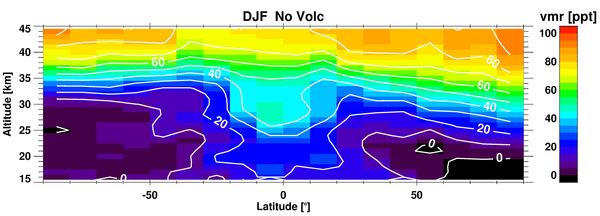MIPAS observation of sulphur dioxide (SO2) in the stratosphere

Mean meridional distribution of SO2 during Dec/Jan/Feb for years with minor volcanic influence.
Sulphur dioxide (SO2) is one of the key species determining the aerosol content of the Earth’s stratosphere. This so-called Junge-layer is situated at altitudes between 15 and 30 km and consists of particles mainly composed of sulphuric acid. The aerosols cool the atmosphere by scattering sunlight back into space – an effect which is mainly visible during enhanced stratospheric aerosol loading in the aftermath of large volcanic eruptions, like Pinatubo in 1991. The particles of the Junge layer are produced in the stratosphere from SO2 which is either directly injected e.g. through volcanoes or which itself is a product from COS (carbonyl sulfide).
Observations of stratospheric SO2 have been rare: only three altitude profiles of SO2 concentration existed between 30 and 50 km, two of them in volcanically perturbed situations, and no data at all between 20 and 30 km. This gap could be closed with the recent analysis of MIPAS data performed at KIT/IMK-ASF. On basis of monthly and zonally averaged MIPAS spectra we could retrieve time series of stratospheric SO2 from 2002 until 2012.
The observations are the first experimental confirmation of several features of the stratospheric SO2 distribution, like the local maximum at around 25–30 km altitude or the downwelling of SO2-rich air to altitudes of 25–30 km at high latitudes during winter and its subsequent depletion on availability of sunlight as trigger for the so-called CN (condensation nuclei)-explosion at high latitudes in spring. The data will further help to improve atmospheric models of the sulphur cycle some of which are e.g. used to understand possible impacts of climate engineering measures.
For further details see http://www.atmos-chem-phys.net/13/10405/2013/acp-13-10405-2013.html
Data available at http://www.imk-asf.kit.edu/english/308.php
